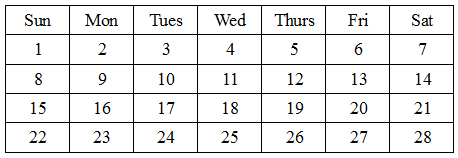In 1899, British statistician Moses B. Cotsworth noted that recordkeeping could be greatly simplified if each month contained a uniform number of whole weeks. He proposed an “international fixed calendar” containing 13 months of 28 days each:

This makes everything easier. The 26th of every month falls reliably on a Thursday, for example, and statistical comparisons between months are made more accurate, as each month contains four tidy weeks with four weekends. (Unfortunately for the superstitious, every one of the 13 months contains a Friday the 13th.) A new month, called Sol, would be wedged between June and July, and an extra day, “Year Day,” would be added at the end of the year, but it would be independent of any month (as would Leap Day).
In 1922 the League of Nations chose Cotsworth’s plan as the most promising of 130 proposed calendar reforms, but the public, as always, resisted the unfamiliar, and by 1937 the International Fixed Calendar League had closed its doors. It left one curious legacy, though: George Eastman, the founder of Eastman Kodak, was so pleased with Cotsworth’s scheme that he adopted it as his company’s official calendar — and it remained so until 1989.
